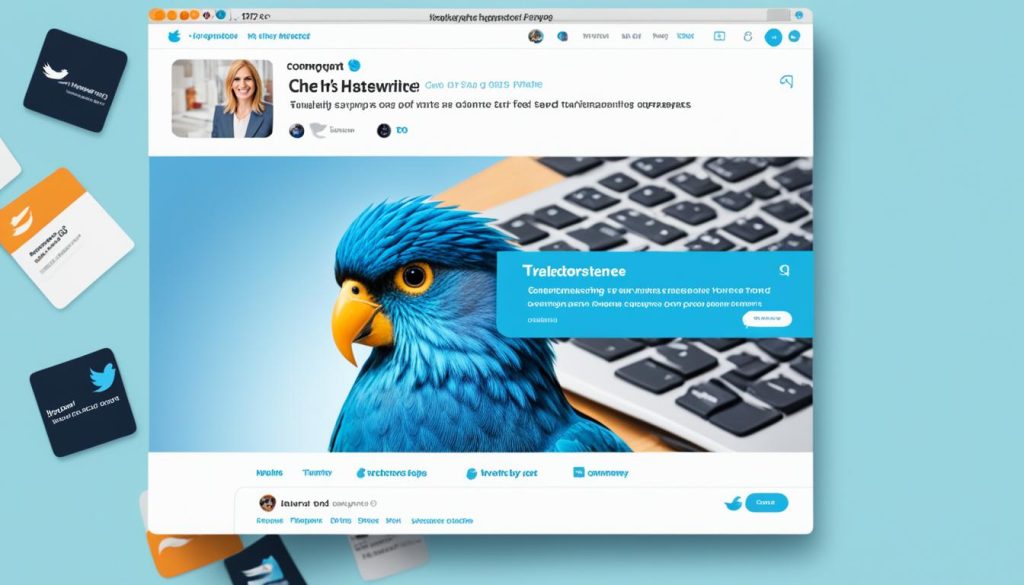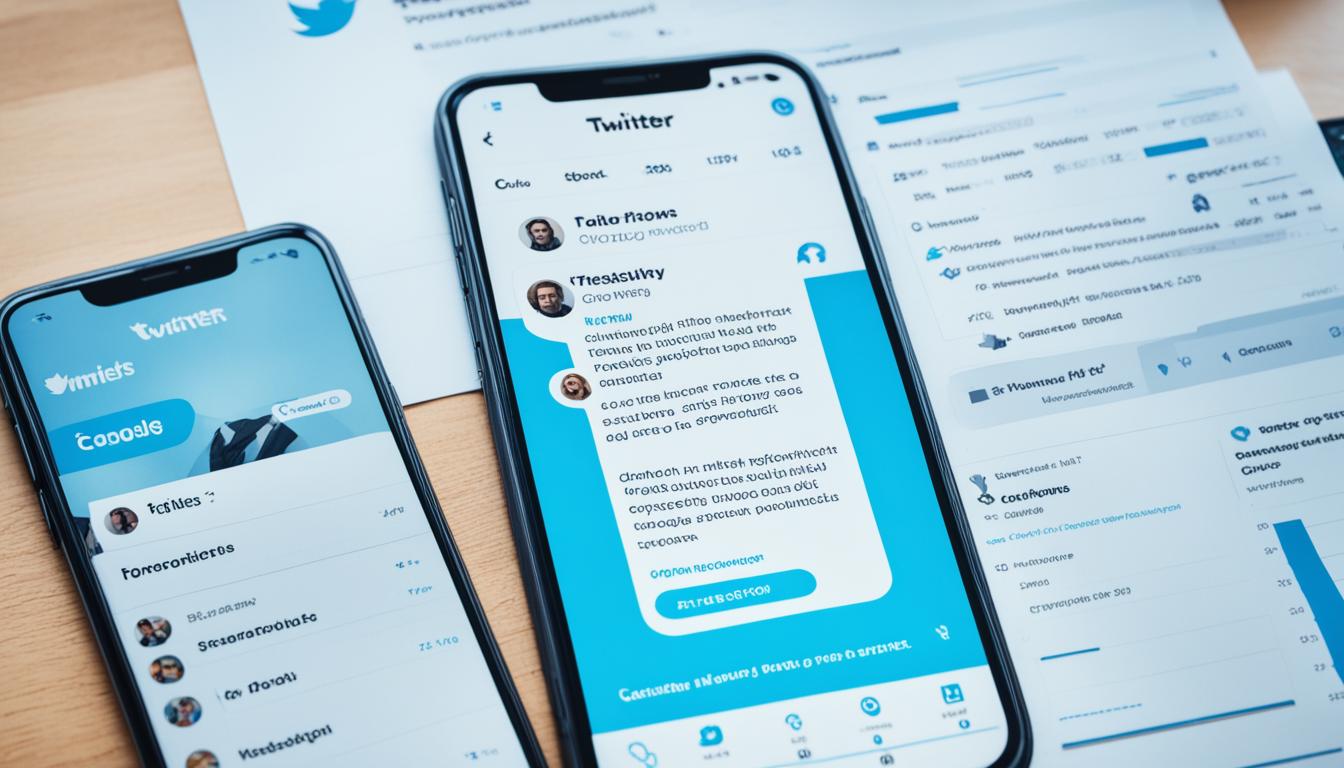Twitter has become an integral part of many businesses’ social media marketing strategies. With 187 million daily active users, this platform offers a plethora of opportunities to engage with your audience, enhance brand visibility, and drive business growth. In this comprehensive guide, we will explore the benefits and strategies of using Twitter for business, empowering you to unlock the full potential of this powerful social media platform.
Join us on this Twitter journey as we uncover the key tactics, best practices, and insights that will empower you to use Twitter effectively for your business. Are you ready to harness the power of Twitter for business success? Let’s dive in!
Understanding Twitter for Business
Twitter has become a vital platform for businesses to connect with their audience and promote their brand. With its extensive reach and advertising opportunities, Twitter offers numerous advantages for businesses looking to enhance their digital marketing efforts and online branding.
One of the key benefits of using Twitter for business is the ability to reach a wider audience. With 187 million daily active users, Twitter provides a vast pool of potential customers who can engage with your brand and become loyal advocates. By leveraging targeted advertising options and optimizing your tweets with relevant keywords, you can effectively reach your target audience and drive more traffic to your website.
Twitter advertising plays a crucial role in promoting businesses on the platform. Whether it’s through Promoted Tweets, Promoted Accounts, or Promoted Trends, businesses have the opportunity to boost their visibility and increase brand awareness. By strategically planning and executing Twitter advertising campaigns, businesses can drive engagement, attract new followers, and generate leads.
Advantages of Twitter for Business:
- Digital Marketing: Twitter offers a range of features and tools that facilitate effective digital marketing strategies. From targeted advertising to content promotion, businesses can leverage Twitter to enhance their digital marketing campaigns and achieve their marketing objectives.
- Online Branding: Establishing a strong online brand presence is crucial for business success. Twitter provides businesses with an opportunity to showcase their brand personality, engage with followers, and build brand loyalty.
| Advantages | Twitter for Business |
|---|---|
| Increased Reach | Connect with a wider audience and expand your brand’s reach. |
| Advertising Opportunities | Utilize Twitter advertising options to boost brand visibility and attract new customers. |
| Brand Engagement | Engage with followers, build relationships, and enhance brand loyalty. |
| Content Promotion | Effectively promote your content and drive traffic to your website or blog. |
By leveraging the power of Twitter advertising, businesses can effectively target their audience, increase brand visibility, and drive conversions. However, it’s important to develop a comprehensive digital marketing strategy that aligns with your business goals and objectives.
In the next section, we will explore the step-by-step process of setting up a Twitter account for your business, including the latest updates for 2021.
How to Set Up Your Business Twitter Account?
Setting up a Twitter account for your business is crucial to starting your journey on the platform. This section will provide a step-by-step guide on creating and optimizing your business Twitter account, including the latest updates for 2021.
Step 1: Sign Up or Log In
If you already have a personal Twitter account, you can log in using your existing credentials. Otherwise, visit the Twitter homepage and click on the “Sign Up” button to create a new account. Fill in your business name, email address, and password to begin.
Step 2: Customize Your Profile
Once you’ve created your account, it’s time to customize your profile to reflect your business. Upload a high-quality logo or profile picture that represents your brand. Write a brief and engaging bio that describes your business and what you offer. Don’t forget to include a link to your website or landing page to drive traffic.
Step 3: Follow Relevant Accounts
To stay updated with industry news and connect with potential customers, start following relevant accounts in your industry. Look for industry leaders, influencers, and organizations that align with your business goals. Engaging with their content and participating in conversations will help you establish your presence on Twitter.
Step 4: Create Engaging Content
To attract and retain followers, create engaging content that provides value to your target audience. Share industry insights, tips, and relevant news. Utilize images, videos, and GIFs to make your tweets visually appealing. Incorporate hashtags relevant to your business to increase discoverability and reach.
Step 5: Engage with Your Audience
Engagement is key to building a loyal Twitter following. Respond to comments, retweet interesting content, and participate in conversations. Use Twitter’s advanced search or relevant hashtags to find conversations related to your industry and join in. Building relationships with your audience will help establish your brand and drive engagement.
Step 6: Analyze and Optimize
Take advantage of Twitter’s analytics tools to gain insights into your account’s performance. Monitor your tweet engagement, follower growth, and audience demographics. Use this data to optimize your content strategy, identify trends, and refine your Twitter marketing approach for better results.

Setting up your business Twitter account doesn’t have to be complicated. By following these steps and staying consistent with your content strategy, you can leverage the power of Twitter to reach and engage with your target audience in 2021.
Creating a Professional Profile and Building Your Brand
To establish your brand and attract followers on Twitter, it is crucial to create a professional profile that effectively represents your business. A well-crafted profile helps build credibility and encourages users to engage with your content. Additionally, managing your social media content strategically plays a significant role in establishing a strong online presence.
Creating a Compelling Profile
When creating your Twitter profile, it’s important to consider the following elements:
- Profile Picture: Use a high-quality, recognisable image such as your business logo or a professional headshot for personal brands.
- Username: Choose a username that reflects your brand and is easy to remember. Ideally, it should be your business name or a variation thereof.
- Bio: Craft a concise and engaging bio that describes your business, highlights key offerings, and includes relevant keywords.
- Header Image: Utilize the header image to convey your brand’s personality, showcase your products or services, or feature current promotions.
- Website URL: Link your Twitter profile to your business website or a dedicated landing page to drive traffic and convert followers into customers.
Remember, your profile serves as the first impression of your brand on Twitter. A well-curated and visually appealing profile increases the likelihood of attracting and retaining followers.
Managing Social Media Content
Consistently delivering valuable and engaging content is key to building your brand on Twitter. Consider the following strategies:
- Content Calendar: Create a content calendar to plan and schedule your tweets. This allows for a consistent posting frequency and ensures diverse and relevant content.
- Value-driven Content: Offer a mix of informative, entertaining, and promotional content. Provide valuable insights, industry updates, and tips that resonate with your target audience.
- Visual Content: Incorporate visually appealing elements such as images, videos, and infographics to capture the attention of users as they scroll through their feeds.
- Hashtags: Utilize hashtags strategically to increase your visibility and reach on Twitter. Research and use relevant industry-specific hashtags and popular trends to amplify your reach.
- Engagement: Actively engage with your followers by responding to comments, mentions, and direct messages. This fosters a sense of community and strengthens customer relationships.
By effectively managing your social media content, you can position your brand as a thought leader, attract a loyal following, and drive meaningful interactions with your target audience.
Strategies for Small Businesses to Succeed on Twitter
For small businesses looking to thrive on Twitter, consider implementing the following strategies:
- Targeted Networking: Engage with other businesses, industry influencers, and potential customers by participating in relevant conversations and retweeting valuable content.
- Local Community Involvement: Leverage Twitter to connect with local communities through geotargeted content, community events, and partnerships with local businesses.
- Customer Feedback and Support: Utilize Twitter as a platform to provide exceptional customer support, address feedback, and respond to inquiries promptly. This demonstrates your commitment to customer satisfaction.
- Partnerships and Collaborations: Strengthen your brand’s visibility by partnering with complementary businesses or influencers. Collaborative campaigns and co-branded content can reach new audiences.
With a well-thought-out profile, strategically managed content, and targeted strategies, small businesses can maximize their presence on Twitter and thrive in the digital landscape.
Building Your Twitter Following
Growing your Twitter following is essential for expanding your reach, increasing brand awareness, and driving business growth on the platform. With the right strategies and tactics, you can attract a relevant audience and establish a strong presence. Here are some effective ways to build your Twitter following:
Create Compelling Content
One of the main reasons to use Twitter for business is the opportunity to share valuable and engaging content with your audience. By consistently posting high-quality tweets, you can attract followers who are interested in your industry and offerings. Make sure your content is informative, entertaining, and relevant to your target audience’s needs and interests.
Engage with Your Audience
Twitter is a highly interactive platform, and engaging with your audience is crucial for building relationships and attracting new followers. Respond to comments, mentions, and direct messages promptly and sincerely. Like and retweet relevant content from other users to show your support and build connections. By actively engaging with your audience, you can foster a sense of community and encourage others to follow your account.
Utilize Hashtags
Hashtags are a powerful tool for increasing your Twitter visibility and reaching a wider audience. Research and use relevant hashtags in your tweets to expand your reach beyond your existing followers. By using popular and trending hashtags, you can tap into ongoing conversations and attract users who are interested in the topics you’re discussing.
Collaborate with Influencers
Influencer marketing on Twitter can significantly boost your follower count and increase your brand’s credibility. Identify influential users in your industry and build relationships with them. Collaborate on content, engage with their tweets, and leverage their audience to gain exposure. When an influencer shares or mentions your content, it can lead to a surge in followers and brand recognition.
Promote Your Twitter Account
Make sure to promote your Twitter account on your other marketing channels to increase visibility. Add social media icons and links to your website, blog, email signature, and other online platforms. Encourage your existing audience to follow you on Twitter by highlighting the benefits they’ll gain from engaging with your content and updates.
| Number of Followers | Action |
|---|---|
| 0-500 | Focus on creating engaging content and engaging with your target audience. Utilize relevant hashtags to increase your reach. |
| 500-1000 | Collaborate with influencers in your industry to expand your reach and attract new followers. |
| 1000-5000 | Promote your Twitter account on your other marketing channels and encourage your existing audience to follow you. |
| 5000+ | Continue providing valuable content, engaging with your audience, and leveraging your influence to attract new followers. |
By implementing these strategies and consistently putting effort into building your Twitter following, you can create a strong online presence, connect with your target audience, and drive business growth on the platform.

Strategies for Growing Your Audience and Engaging With Customers
Engaging with your audience is crucial for building strong customer relationships and driving business success on Twitter. By implementing effective strategies for audience growth and leveraging customer engagement tactics, you can establish a powerful presence on the platform and unlock its full potential for your business.
1. Optimize Your Profile
To attract more followers and engage with your target audience, optimize your Twitter profile to reflect your brand identity. Use clear and concise descriptions, incorporate relevant keywords, and ensure your profile picture and header image align with your brand aesthetics. This will create a positive first impression and encourage users to explore your content further.
2. Provide Valuable Content
Deliver high-quality and relevant content that adds value to your audience. Share industry insights, expert advice, and unique perspectives to position yourself as a thought leader. Be consistent in posting engaging tweets, articles, videos, and images that resonate with your target market. This will attract followers and encourage them to engage with your brand.
3. Utilize Hashtags
Effective hashtag usage can enhance your reach and visibility on Twitter. Research popular hashtags in your industry and incorporate them into your tweets to ensure your content reaches a wider audience. Additionally, create unique branded hashtags to encourage user-generated content and promote engagement with your brand.
4. Engage in Conversations
Actively participate in conversations by responding to comments, mentions, and direct messages. Show genuine interest in your audience’s opinions and concerns. By engaging in conversations, you can strengthen relationships, build trust, and demonstrate your commitment to customer satisfaction.
5. Run Contests and Giveaways
Contests and giveaways are excellent tactics to engage with your audience and attract new followers. Offer valuable prizes related to your products or services in exchange for likes, retweets, or user-generated content. This not only boosts engagement but also creates a buzz around your brand.
6. Collaborate with Influencers
Partnering with influencers who align with your brand can significantly increase your reach, credibility, and engagement on Twitter. Identify influential individuals in your industry and collaborate with them on content, campaigns, or events. Their endorsement and audience engagement can amplify your message and help you connect with a wider audience.
7. Analyze and Adapt
Regularly analyze your Twitter performance using analytics tools. Determine which content resonates most with your audience, what engagement tactics are effective, and how to optimize your strategy further. Use these insights to adapt and refine your approach, ensuring continuous growth, and improvement.
| Benefits | Social Media | Business |
|---|---|---|
| Builds strong customer relationships | ✓ | ✓ |
| Drives business success on Twitter | ✓ | ✓ |
| Increases brand visibility | ✓ | ✓ |
| Attracts new followers | ✓ | ✓ |
| Enhances customer engagement | ✓ | ✓ |
Creating and Sharing Content on Twitter
When it comes to attracting and retaining followers on Twitter, creating and sharing compelling content is crucial. A well-defined content strategy will not only engage your audience but also help establish your brand’s credibility and authority in your industry. To make the most out of your Twitter presence, you need to understand how to develop a content strategy, leverage hashtags effectively, and utilize Twitter analytics to optimize content performance.
Developing a Twitter Content Strategy
A strong Twitter content strategy is the foundation for successful engagement and follower growth. Your strategy should focus on delivering valuable, informative, and engaging content that resonates with your target audience. Keep these essential elements in mind:
- Create a content calendar: Plan and organize your Twitter content in advance to ensure consistency and maintain a steady stream of valuable information.
- Identify your target audience: Understand your audience’s interests, pain points, and preferences to tailor your content specifically to their needs.
- Vary your content types: Experiment with different content formats such as text-based tweets, images, videos, and links to keep your feed diverse and engaging.
- Use a mix of curated and original content: Share relevant industry news, articles, and insights from thought leaders alongside your original content to provide a comprehensive experience for your followers.
- Engage with your audience: Encourage conversation, respond to comments and mentions, and actively participate in discussions related to your industry to foster meaningful connections with your followers.
Leveraging Hashtags Effectively
Hashtags are essential for increasing the visibility and reach of your Twitter content. When used strategically, hashtags can help your tweets appear in relevant conversations and trending topics. Here are some best practices for using hashtags on Twitter:
- Research relevant hashtags: Identify popular and trending hashtags that are relevant to your industry or the content you’re sharing. Tools like Twitter’s search bar and hashtag tracking software can help you find the most effective hashtags.
- Be specific and targeted: Use hashtags that are concise and specific to your content to attract relevant users who are interested in your niche.
- Avoid overusing hashtags: While hashtags can enhance discoverability, using too many hashtags in a single tweet can appear spammy and cluttered. Limit your hashtags to 1-2 per tweet for optimal results.
- Create branded hashtags: Develop unique hashtags for your brand or specific campaigns to increase brand awareness and encourage user-generated content.
Optimizing Content Performance with Twitter Analytics
To make informed decisions about your Twitter content strategy, it’s crucial to leverage Twitter analytics. Twitter provides valuable insights into your audience, engagement metrics, and content performance. Here’s how you can use Twitter analytics to optimize your content strategy:
- Analyze audience demographics: Identify key audience insights such as age, gender, location, and interests to tailor your content to their preferences.
- Track engagement metrics: Monitor your tweet impressions, engagement rate, retweets, likes, and replies to evaluate the performance of your content and identify which types of tweets resonate most with your audience.
- Identify influential followers: Analyze your followers to identify influential accounts who can help amplify your content reach and engage with them to build mutually beneficial relationships.
- Experiment and iterate: Use the data from Twitter analytics to experiment with different content strategies, hashtags, and posting times. Continuously evaluate the results and refine your approach based on what resonates best with your audience.

By developing a thoughtful content strategy, utilizing hashtags effectively, and leveraging Twitter analytics, you can enhance your presence on Twitter and attract a dedicated following. With consistent and engaging content, you’ll be well on your way to building brand awareness, improving audience engagement, and driving business success on the platform.
| Benefits of Creating and Sharing Content on Twitter | Twitter Content Strategy Best Practices |
|---|---|
| Increases brand visibility | Create a content calendar for consistent posting |
| Drives website traffic | Identify your target audience and tailor content to their needs |
| Positions your brand as a thought leader | Vary content types to keep your feed diverse and engaging |
| Engages and builds relationships with followers | Use a mix of curated and original content |
| Influences purchase decisions | Engage with your audience to foster meaningful connections |
Best Practices for Tweeting and Using Visuals
Tweeting strategically and incorporating visuals are essential for maximizing your impact on Twitter. By following these best practices, you can effectively engage your audience, increase brand awareness, and drive reach.
1. Craft Compelling Tweets
When composing tweets, focus on creating concise and engaging content. Use attention-grabbing headlines, relevant hashtags, and compelling visuals to capture your audience’s interest. Incorporate the keywords related to your small business to optimize discoverability and enhance your brand’s visibility in search results.
2. Use Visuals to Tell Your Story
Visuals play a powerful role in conveying your brand’s message and capturing your audience’s attention. Include eye-catching images, infographics, and videos in your tweets to make them more visually appealing and shareable. Visual content has been shown to increase engagement and can significantly enhance brand awareness on Twitter.
3. Embrace Multimedia Formats
Experiment with different multimedia formats to diversify your content and keep your audience engaged. Besides images and videos, consider incorporating GIFs, polls, and Twitter Moments into your tweets. These formats add variety to your content and encourage interaction, making your brand more memorable and increasing engagement.
4. Engage With Your Audience
Building a strong presence on Twitter requires active engagement with your audience. Respond to mentions, comments, and direct messages promptly to show your followers that you value their input. Retweet and like relevant content from your followers and industry influencers to foster relationships and increase your brand’s visibility.
5. Analyze and Optimize Your Tweets
Regularly monitor your Twitter analytics to gain insights into your tweet performance. Pay attention to metrics such as engagement rate, reach, and click-through rate to understand what works best for your small business. Use this data to refine your tweeting strategy and optimize future tweets for maximum impact.
By implementing these best practices, you can unlock the full potential of Twitter for your small business, increase your brand’s reach, and drive meaningful engagement with your audience. Remember to tailor your approach to your target audience, staying consistent with your brand’s identity and values.
Twitter Advertising
Twitter offers a range of advertising opportunities to help businesses enhance their presence on the platform and reach their target audience effectively. By incorporating Twitter ads into your marketing strategy, you can maximize your efforts and grow your business on Twitter.
One of the key benefits of Twitter advertising is its ability to increase brand visibility. With promoted tweets, you can showcase your content to a wider audience, ensuring your message reaches potential customers who may not have discovered your brand otherwise.
Twitter ads also allow for precise targeting, enabling you to reach the right audience at the right time. By defining specific demographics, interests, and location parameters when setting up your ads, you can ensure that your message resonates with the most relevant individuals, increasing the likelihood of engagement and conversions.
Types of Twitter Ads
Twitter offers various ad formats to suit different marketing objectives:
- Promoted Tweets: These are regular tweets that you pay to promote to a wider audience. They appear prominently in users’ Twitter feeds and can include media, such as images or videos, to capture attention.
- Twitter Moments Ads: Twitter Moments are curated collections of tweets that tell a story or cover a specific topic. With Moments Ads, you can sponsor these collections to increase exposure and engagement.
- Promoted Trends: Promoted Trends allow you to place your brand or hashtag at the top of the Trends list on Twitter. This can generate significant visibility and spark conversations around your brand.
- In-Stream Video Ads: These ads play before or during video content on Twitter, providing an opportunity to captivate your audience with engaging video content.
- Website Clicks or Conversions: These ads drive traffic to your website or landing page, encouraging users to take a specific action, such as making a purchase or signing up for a newsletter.
Each ad format offers unique features and benefits, allowing you to tailor your advertising strategy to meet your specific goals.

Maximizing Your Twitter Ads
To make the most of your Twitter advertising campaigns, consider the following tips:
- Set clear objectives: Determine what you want to achieve with your Twitter ads, whether it’s increasing brand awareness, driving website traffic, or generating leads. This will help you structure your campaigns effectively.
- Create compelling ad content: Craft attention-grabbing headlines, engaging copy, and compelling visuals to capture the interest of your target audience and encourage them to take action.
- Utilize targeting options: Take advantage of Twitter’s targeting capabilities to reach the most relevant audience for your brand. Define key demographics, interests, and geographic parameters to optimize the performance of your ads.
- Monitor and adjust: Regularly review the performance of your Twitter ads using the platform’s analytics. Identify what’s working and what’s not, and make necessary adjustments to improve your campaign’s effectiveness.
By implementing these strategies, you can leverage Twitter advertising to grow your business, increase brand visibility, and reach your target audience effectively.
| Benefits of Twitter Advertising | Tips for Success |
|---|---|
| Increased brand visibility | Set clear objectives |
| Precise targeting | Create compelling ad content |
| Various ad formats | Utilize targeting options |
| Opportunity for engagement | Monitor and adjust |
Tools and Metrics for Tracking Your Success
Tracking and analyzing your Twitter performance is crucial for measuring success and making data-driven decisions. To effectively monitor your Twitter analytics and optimize your Twitter strategy, you can utilize the following tools and metrics:
Social Media Management Tools
Using social media management tools like Hootsuite, Buffer, or Sprout Social can help you track and analyze your Twitter activity. These tools provide features such as scheduling posts, monitoring engagement metrics, and generating detailed analytics reports.
Twitter Analytics Dashboard
Twitter offers its built-in analytics dashboard, which provides valuable insights into your account’s performance. It includes metrics like impressions, engagements, and follower growth. By regularly reviewing this data, you can identify trends, measure the impact of your tweets, and refine your content strategy.
| Metrics | Description |
|---|---|
| Impressions | The number of times your tweet or content was viewed by Twitter users |
| Engagements | The total interactions (likes, retweets, replies, and clicks) on your tweets |
| Reach | The number of unique Twitter users who saw your tweet |
| Profile visits | The number of times users visited your Twitter profile |
| Follower growth | The change in the number of followers over a specific period |
Conversion Tracking
By using Twitter’s conversion tracking feature, you can measure the effectiveness of your Twitter campaigns in driving specific actions, such as website visits, app installations, or purchases. It allows you to track the performance of your tweets and optimize your advertising efforts.
Hashtag and Keyword Tracking
Monitoring the performance of hashtags and keywords related to your business can provide insights into trending topics, competitor analysis, and audience engagement. Tools like Hashtagify, Keyhole, and TweetReach can help you identify popular hashtags, track their reach, and measure their impact on your Twitter presence.
By employing these tools and metrics, you can gain valuable insights into your Twitter performance, understand key performance indicators, and make data-driven decisions to optimize your Twitter strategy.
Conclusion
Twitter is a powerful platform that businesses can leverage to enhance their online presence, engage with customers, and drive growth. By incorporating Twitter into your digital marketing and social media strategies, you can tap into its unlimited potential and reap the benefits it offers.
Throughout this guide, we have explored how to use Twitter for business and the various strategies you can implement to maximize its impact. From creating a professional profile and building your brand to growing your Twitter following and engaging with your audience, each step plays a crucial role in your success on the platform.
Additionally, by focusing on creating and sharing compelling content, utilizing visuals effectively, and leveraging Twitter advertising opportunities, you can further amplify your business presence and increase brand awareness. Tracking your success through Twitter analytics and making data-driven decisions will further refine your strategy and drive continued growth.
In conclusion, Twitter is not just a platform for social interaction but also a valuable tool for businesses. By harnessing the power of Twitter for business and integrating it into your digital marketing and social media strategies, you can unlock new opportunities, expand your reach, and achieve your business objectives.





